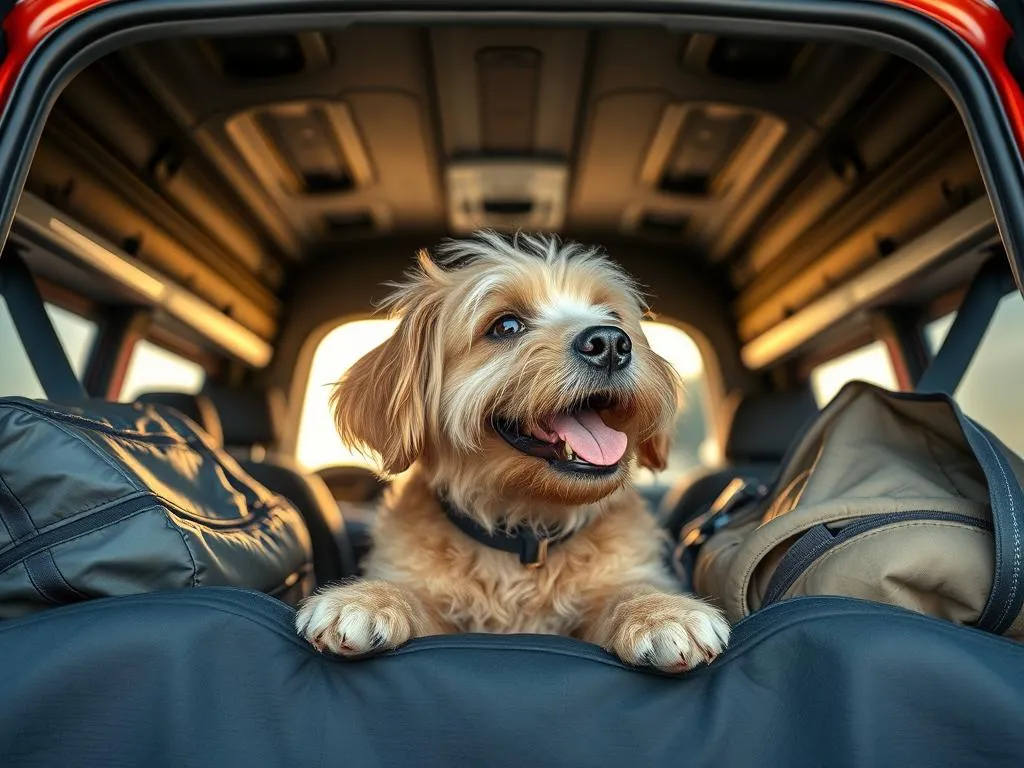
Introduction
Traveling with pets has become increasingly popular in recent years. As more pet owners embark on adventures, the question arises: is your pet safe flying in cargo? Understanding the nuances of air travel with dogs is essential, especially when considering cargo options. While many pets travel comfortably in the cabin, others must go through cargo, either due to size restrictions or airline policies.
In this blog post, we will delve into the intricacies of cargo travel for pets. We aim to provide you with valuable insights and practical tips to ensure your dog’s health and safety when traveling by air. By being well-informed, you can make the best decision for your furry friend and ensure a smooth travel experience.
Understanding Cargo Travel for Pets
What is Cargo Travel?
Cargo travel refers to transporting pets in a designated area of the airplane, separate from the passenger cabin. This option is typically necessary for larger breeds that exceed cabin size limits or for airlines that do not allow pets in the cabin due to safety regulations.
Cargo travel differs significantly from cabin travel. In the cabin, pets can stay with their owners, providing comfort and familiarity. In contrast, cargo travel means your dog will be placed in a temperature-controlled area of the aircraft, away from you, which can create anxiety for both the pet and the owner.
Why Do Owners Choose Cargo?
Several situations may necessitate cargo travel for pets:
- Size Limitations: Many airlines have strict size restrictions for pets traveling in the cabin. If your dog exceeds these limits, cargo may be the only option.
- Breed Restrictions: Certain breeds, especially brachycephalic (flat-faced) breeds like Bulldogs or Pugs, may be banned from cabin travel due to respiratory risks. Cargo might be the safer alternative.
- Long-Distance Travel: Some owners prefer cargo for long flights, as it allows their pet to rest without the distractions of cabin noise and activity.
Choosing cargo can be beneficial when you understand the potential risks and prepare adequately for your dog’s journey.
Assessing Your Dog’s Suitability for Cargo Travel
Health Considerations
Before booking a flight, it’s crucial to assess your dog’s health. Airlines typically require a health certificate issued by a veterinarian before travel. This certificate confirms that your pet is fit to fly and does not pose a risk to itself or others.
Common health issues that may affect cargo travel include:
- Respiratory Problems: Dogs with existing respiratory issues may struggle in the cargo hold due to the pressure changes and potential stress.
- Age-Related Concerns: Very young or elderly dogs may not handle the flight well and could be better off traveling by other means.
Always consult with your vet to determine if your dog is ready for cargo travel.
Breed-Specific Considerations
Certain dog breeds are more susceptible to the challenges of cargo travel. Brachycephalic breeds, for example, are at higher risk for respiratory distress during flights. If you own one of these breeds, it’s vital to consider the airline’s policies and potential health risks before committing to cargo travel.
Conversely, breeds like Labrador Retrievers or Golden Retrievers generally fare better in cargo due to their robust health and adaptability.
Preparing Your Dog for Cargo Travel
Pre-Travel Health Check
Scheduling a vet visit before your trip is essential. During this visit, ensure that your dog is up to date on vaccinations and discuss any health concerns you may have.
Some airlines require specific vaccinations, so it’s best to check their policies and ensure your dog has all the necessary health certificates. This proactive approach can help avoid last-minute complications.
Choosing the Right Crate
Selecting an IATA-approved crate is crucial for your dog’s safety and comfort during travel. Here are some guidelines:
- Size: The crate should be large enough for your dog to stand, turn around, and lie down comfortably.
- Ventilation: Ensure the crate has adequate ventilation on all sides.
- Sturdiness: Choose a crate made from durable materials that can withstand the rigors of air travel.
Additionally, crate training your dog before the trip is essential. Gradually introduce them to the crate, allowing them to explore and spend time inside. This process can help alleviate anxiety and create a positive association with the crate.
Familiarization Techniques
Acclimating your dog to the crate is vital for a stress-free experience. Here are some techniques to consider:
- Positive Reinforcement: Reward your dog with treats and praise when they enter the crate.
- Short Stays: Start by having your dog spend short periods in the crate, gradually increasing the duration.
- Comfort Items: Include a familiar blanket or toy in the crate to provide comfort during the flight.
Creating a positive experience with the crate can significantly reduce your dog’s stress levels during travel.
Safety Tips for Flying Dogs in Cargo
Choosing the Right Airline
Not all airlines treat pets flying in cargo the same way. When selecting an airline, consider the following factors:
- Pet Policies: Research each airline’s pet travel policies. Some have stricter regulations than others.
- Cargo Conditions: Inquire about the cargo hold’s temperature control and ventilation, as these factors are crucial for your pet’s well-being.
- Reviews: Look for reviews from other pet owners regarding their experiences with the airline’s cargo service.
Choosing an airline with a positive reputation for pet travel can provide peace of mind.
Weather Considerations
Weather can significantly impact your dog’s safety during cargo travel. Airlines often have temperature restrictions for cargo travel, especially in extreme weather conditions.
- Hot Weather: If temperatures exceed a certain threshold, airlines may refuse to transport pets in cargo to prevent heat-related illnesses.
- Cold Weather: Similarly, extremely low temperatures can pose risks, especially for smaller or short-haired breeds.
Check the weather forecast for your travel dates and be prepared to adjust your plans if necessary.
What to Pack for Your Dog
Packing the right items for your dog’s cargo journey is essential. Here’s a brief list of essential items to include:
- Food and Water: Pack a small amount of your dog’s regular food and water for the journey. Some airlines allow you to attach a water bottle to the crate.
- Comfort Items: Include a familiar blanket or toy to help soothe your pet.
- Identification: Ensure the crate is labeled with your contact information, including your name, phone number, and destination.
Being prepared can help ensure your dog’s comfort and safety during the flight.
During the Flight
Monitoring Your Dog’s Well-Being
While you cannot be with your dog during cargo travel, knowing what to expect can help ease your worries. Many pets handle the flight well, but some may experience stress or anxiety.
Signs of stress in dogs can include:
- Excessive barking or whining
- Panting or drooling
- Attempts to escape the crate
If you notice these signs, it’s essential to address your dog’s needs as best as you can.
Communication with Airline Staff
Before your flight, inform the airline staff about your pet. Let them know your dog is traveling in cargo and provide any relevant information regarding their health or behavior.
Being proactive can help ensure that your pet receives the necessary care during the flight.
After the Flight: Ensuring Your Dog’s Health
Immediate Post-Flight Actions
Once you arrive at your destination, the first thing to do is pick up your dog from the cargo area. It’s crucial to check on their condition immediately. Look for any signs of distress or discomfort, such as:
- Lethargy or disorientation
- Excessive drooling or panting
- Vomiting or diarrhea
If you notice any concerning symptoms, consult a veterinarian as soon as possible.
Reintegrating Your Dog
After a long journey, your dog may need time to adjust. Here are some tips to help them reintegrate:
- Create a Calm Environment: Allow your dog to settle in a quiet space in your new location.
- Monitor Behavior: Watch for any changes in behavior, such as decreased appetite or reluctance to engage in normal activities.
- Routine: Establish a consistent routine for feeding, walks, and playtime to help your dog feel secure.
Monitoring your dog’s behavior and health in the days following travel is essential for ensuring their well-being.
Conclusion
Traveling with your dog can be a rewarding experience, but it requires careful planning and preparation, especially when considering is your pet safe flying in cargo. Understanding the intricacies of cargo travel, assessing your dog’s suitability, and preparing adequately can make all the difference in ensuring a safe and comfortable journey.
By following the tips and insights outlined in this article, you can help ensure your pet’s health and safety during air travel. Remember that being informed and prepared is the key to a successful trip for both you and your furry friend.
Your pet’s well-being is always worth the extra effort!









